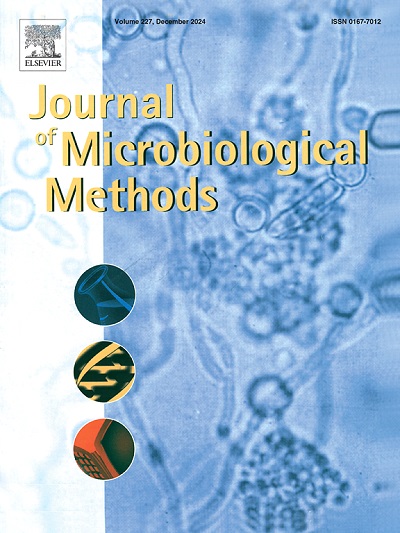Development of polymerase chain reaction assays specific for individual pathogenic Aeromonas species
IF 1.7
4区 生物学
Q4 BIOCHEMICAL RESEARCH METHODS
引用次数: 0
Abstract
The genus Aeromonas, a group of Gram-negative bacilli, inhabits a wide variety of aquatic environments, including rivers, lakes, and coastal seas. Among Aeromonas species, A. hydrophila, A. caviae, A. veronii, and A. dhakensis are clinically important species that cause infections in humans, leading to diarrhea associated with gastroenteritis, necrotizing fasciitis, and sepsis. A. dhakensis is a newly established species that was reclassified in 2013, and it is considered more pathogenic than other Aeromonas species. However, accurate identification of Aeromonas species by biochemical characteristics, mass spectrometry, and 16S rRNA gene analysis can sometimes be difficult. In this study, 24 strains were classified into nine species by homology and phylogenetic analysis of the RNA polymerase B subunit gene (rpoB), the gold standard method for identifying Aeromonas species. The results of 16S rRNA gene analysis were consistent with those of rpoB analysis for all strains. The results of matrix-assisted laser desorption/ionization time-of-flight mass spectrometry were consistent with those of rpoB analysis for all strains excluding A. dhakensis; however, all five A. dhakensis strains were misidentified as other species. Therefore, we attempted to develop species-specific polymerase chain reactions (PCR) for four pathogenic Aeromonas species. The results of these PCRs were completely consistent with those of rpoB gene analysis. These PCR-based methods can permit the identification of pathogenic Aeromonas species, especially A. dhakensis, more quickly and simply than conventional methods.
单个致病气单胞菌特异性聚合酶链反应检测方法的建立
气单胞菌属是一组革兰氏阴性杆菌,广泛存在于各种水生环境中,包括河流、湖泊和沿海海域。在气单胞菌中,嗜水单胞菌、caviae单胞菌、veronii单胞菌和达肯单胞菌是临床上重要的物种,可引起人类感染,导致腹泻,并伴有胃肠炎、坏死性筋膜炎和败血症。达肯氏单胞菌是2013年重新分类的新种,其致病性被认为高于其他气单胞菌。然而,通过生化特征、质谱分析和16S rRNA基因分析来准确鉴定气单胞菌的种类有时是困难的。本研究通过鉴定气单胞菌种类的金标准方法——RNA聚合酶B亚基基因(rpoB)的同源性和系统发育分析,将24株菌株划分为9种。所有菌株的16S rRNA基因分析结果与rpoB分析结果一致。基质辅助激光解吸/电离飞行时间质谱分析结果与rpoB分析结果一致,除A. dhakensis外;然而,所有5株达肯芽孢杆菌都被误认为是其他物种。因此,我们试图建立四种致病气单胞菌种特异性聚合酶链反应(PCR)。这些pcr结果与rpoB基因分析结果完全一致。这些基于pcr的方法可以比传统方法更快、更简单地鉴定致病性气单胞菌,特别是达肯单胞菌。
本文章由计算机程序翻译,如有差异,请以英文原文为准。
求助全文
约1分钟内获得全文
求助全文
来源期刊

Journal of microbiological methods
生物-生化研究方法
CiteScore
4.30
自引率
4.50%
发文量
151
审稿时长
29 days
期刊介绍:
The Journal of Microbiological Methods publishes scholarly and original articles, notes and review articles. These articles must include novel and/or state-of-the-art methods, or significant improvements to existing methods. Novel and innovative applications of current methods that are validated and useful will also be published. JMM strives for scholarship, innovation and excellence. This demands scientific rigour, the best available methods and technologies, correctly replicated experiments/tests, the inclusion of proper controls, calibrations, and the correct statistical analysis. The presentation of the data must support the interpretation of the method/approach.
All aspects of microbiology are covered, except virology. These include agricultural microbiology, applied and environmental microbiology, bioassays, bioinformatics, biotechnology, biochemical microbiology, clinical microbiology, diagnostics, food monitoring and quality control microbiology, microbial genetics and genomics, geomicrobiology, microbiome methods regardless of habitat, high through-put sequencing methods and analysis, microbial pathogenesis and host responses, metabolomics, metagenomics, metaproteomics, microbial ecology and diversity, microbial physiology, microbial ultra-structure, microscopic and imaging methods, molecular microbiology, mycology, novel mathematical microbiology and modelling, parasitology, plant-microbe interactions, protein markers/profiles, proteomics, pyrosequencing, public health microbiology, radioisotopes applied to microbiology, robotics applied to microbiological methods,rumen microbiology, microbiological methods for space missions and extreme environments, sampling methods and samplers, soil and sediment microbiology, transcriptomics, veterinary microbiology, sero-diagnostics and typing/identification.
 求助内容:
求助内容: 应助结果提醒方式:
应助结果提醒方式:


